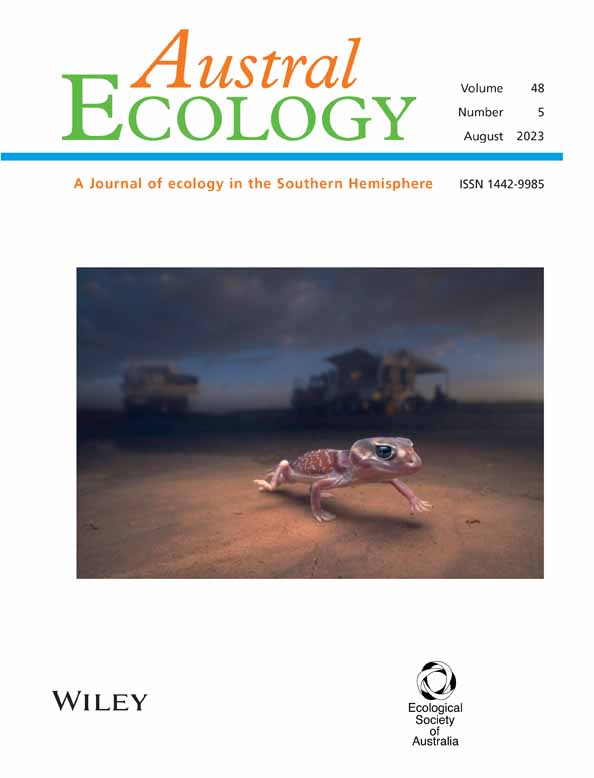Hippos alter their aggregations to mitigate density-dependent drought effects
Abstract
Megaherbivores play a critical role in the ecology of African savannas and grasslands. In addition, these systems are forecast to experience more frequent and severe droughts as a product of changes in the global climate. Thus, the continued conservation of megaherbivores and their associated ecosystems will require a better understanding of how megaherbivores respond to drought by shifting their movement, diet and social behaviour. We address this need by investigating the factors affecting changes in the abundance of common hippopotamus (Hippopotamus amphibius; hereafter: ‘hippos’) throughout the six major rivers of Kruger National Park, South Africa, during and following the severe drought of 2015/2016. Specifically, we aimed to understand the role of two environmental characteristics that have relevance to hippos and that changed in response to drought: vegetation condition and the extent of pooled surface water. In addition, we investigated the extent to which pre-drought density affected changes in hippo abundance. Although vegetation and daytime refugia both appeared to influence pre-drought hippo abundance, these factors were less important to the change in hippo abundance related to the drought. Instead, the response to drought was most strongly related to the pre-drought abundance of hippos, where river segments supporting more than 50 individuals prior to the drought in 2015 decreased by more than half on average. Furthermore, we show that the degree of aggregation decreased from 2015 to 2016 because of the drought, but then began to increase again as the rains returned in 2017. Our results suggest that in addition to the large pools that support large aggregations of hippos in typical years, additional smaller pools are likely important for accommodating this drought-induced dispersion. However, maintaining this distribution of pools will likely become more challenging as southern Africa's population and water demands increase.
INTRODUCTION
The continued loss of species and their ecological functions has reshaped many of the planet's ecosystems. One group of species that is especially vulnerable to extinction is large herbivorous mammals or ‘megaherbivores’ (mammalian herbivores >1000 kg; Owen-Smith, 1987). Extirpated from most of the planet and severely threatened where they persist, the loss and decline of the megaherbivore trophic guild have had outsized effects on the ecological processes that shape ecosystems (Owen-Smith, 1987). Given their large size, megaherbivore populations are rarely sensitive to predation pressure (Owen-Smith, 1988) and instead are limited by their ability to acquire sufficient food resources (Sæther, 1997). Many regularly cover large distances (>100 km) to access food resources, water and mates. Thus, when a population nears carrying capacity, we would expect decreases in resources triggered by extreme weather to initiate hierarchical density-dependent responses from altered movements and social dynamics (e.g. aggregation) to reduced reproduction and recruitment and increased mortality of juveniles and then adults (Bond et al., 2019; Chamaillé-Jammes et al., 2008; Eberhardt, 2002; Sibly et al., 2005; Trimble et al., 2009).
Given well-established relationships between precipitation and herbivore food resources (Olff et al., 2002; Staver et al., 2019; Taylor & Green, 1976), density-dependent impacts on megaherbivores should be most pronounced during periods of drought (Nhleko et al., 2021; Sæther, 1997; Smit et al., 2020), which are expected to occur with increasing frequency over the coming decades (Abiodun et al., 2019). In addition to affecting resource availability, drought can influence the spatial heterogeneity, or aggregation, of megaherbivores (Chamaillé-Jammes et al., 2008). Empirical evidence from a recent prolonged drought suggested that even when restricted to protected areas, elephants were able to mitigate the potential impacts of drought by finding areas of refugia which contained suitable food resources (Abraham et al., 2019). As a result of long-distance movements, drought can increase the spatial heterogeneity in herbivore abundance, with individuals aggregated in areas less affected by drought (Pople et al., 2007). Alternatively, the demographic characteristics of megaherbivore populations, for example, high survival during drought, may buffer demographic variability in response to extreme weather events (Berger, 1997; Trimble et al., 2009). These relationships among resource availability, movement and local density are thus critical to understanding the response of megaherbivores to extreme weather events (Chamaillé-Jammes et al., 2008).
One megaherbivore that is particularly vulnerable to drought impacts is the common hippopotamus (Hippopotamus amphibius; hereafter ‘hippo’). Like other megaherbivores, droughts are likely to limit hippos' ability to obtain enough food to sustain their large mass (Sala et al., 2012; Wilcox et al., 2017). However, because hippos consume primarily grasses, which respond quickly and dramatically to drought, they likely experience more severe food limitations when compared to herbivores that consumed woody browse (Abraham et al., 2019). In addition to their food requirements, hippos are uniquely dependent on pools of surface water for protection from the intense heat and sunlight of African savannas (Field, 1970). After foraging for grass at night, hippos aggregate in riverine pools or other water bodies during the day to protect their skin and regulate their body temperature (Field, 1970). This dependence on daytime refugia may limit their ability to move great distances in search of drought refugia and make them more vulnerable to drought (Smit et al., 2020). Furthermore, their daytime aggregations appear to be important for the establishment and maintenance of social bonds, access to mates, care of the young and avoiding predation (Thévenet et al., 2022). However, this behaviour may also increase competition for food resources and density-dependent population pressure (Blowers et al., 2010), particularly during droughts when resources become scarce (Smuts & Whyte, 1981; Stears et al., 2019, 2021). Although hippos may travel along rivers when pooled surface water becomes limited (Stears et al., 2021), their dependence on daytime refugia limits their ability to move long distances in search of food resources (Smit et al., 2020). Thus, hippo responses to drought could be driven by density-dependent factors, such as intra-specific competition, that are known to influence population dynamics in megaherbivores (Bonenfant et al., 2009; Chamaillé-Jammes et al., 2008). As droughts become more frequent and prolonged (Abiodun et al., 2019), there is a need to better understand the roles of density dependence and resource availability (i.e. water and forage) in contributing to hippo's sensitivity to drought, and hence the contributions hippos make to socio-ecological resilience.
To better understand the drivers of hippo responses to drought, we investigated changes in hippo densities before, during and after a severe drought in Kruger National Park, South Africa. Unlike other megaherbivores that could move long distances to areas with more abundant food resources, hippos' willingness to move may be limited due to fidelity to daytime refugia (i.e. pooled surface water) (Stears et al., 2021). Thus, we expected that declines in hippo densities would be more pronounced in areas where vegetation was most impacted by drought. Furthermore, we expected this resource-driven response to result in increased aggregation in areas where resources were most abundant (Stears et al., 2021). Alternatively, if responses to drought were driven more by the local hippo density prior to the drought than variation in drought severity, we would expect to observe less aggregation during the drought (Chamaillé-Jammes et al., 2008).
METHODS
Study area
We conducted the study in Kruger National Park, South Africa, which supports approximately 7000 individuals and represents one of the largest hippo populations within a single protected area in the world (Eksteen et al., 2016). After discontinuing an era of intensive herd management (e.g. culling) in the 1990s, average hippo densities in Kruger National Park increased steadily from 3.7 individuals/km of river to 7.5 individuals/km (Smit et al., 2020). Covering approximately 19 000 km2, the park encompasses gradients in several environmental conditions that are potentially important to hippos, including elevation and precipitation. With well-defined wet (November–April) and dry seasons (May–October), the park typically receives more than 80% of its rainfall between the summer months of November and April. However, the southern portion of the park receives more rain on average, compared to the northern part of the park (Smit et al., 2020; Staver et al., 2019). The spatial arrangement of the six main rivers with respect to these gradients allowed for the investigation of hippo dynamics at multiple scales.
During 2016, southern Africa experienced widespread and prolonged drought, which provided a useful opportunity to understand the implications of droughts that are likely to become more frequent as a result of climate change (Abiodun et al., 2019). Following the more typical wet season/dry season dynamics of 2014 and 2015, the wet season of early 2016 consisted of little precipitation across the study area, reflected by persisting drought conditions (Figure 1). As such, drought conditions persisted from the dry season of late 2015 through early 2017 when the rains returned, at least in the northern half of the park (Figure 1). In response to drought, several of the park's populations of herbivores suffered dramatic declines (Smit et al., 2020).
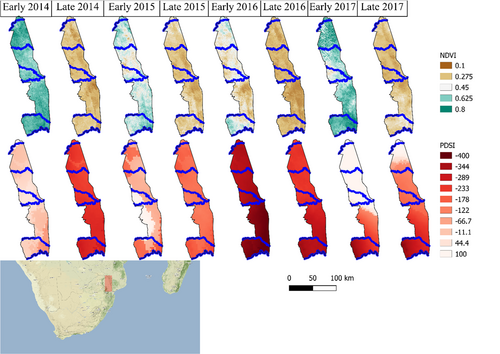
Study design
To understand spatial and temporal variation in hippo responses to drought, we censused hippo populations along each of the six major rivers within Kruger National Park, South Africa, using aerial surveys during the dry seasons of 2015, 2016 and 2017 (see Appendix S1 for details). To evaluate changes in hippos' localized use of habitats, we segmented each river into 1-km stretches, and then buffered these segments by 1 km in the direction perpendicular to the river. Previous work suggests hippos rarely venture >1 km from rivers during the dry season (Stears et al., 2019). These buffered segments served as sampling units. We summed observations of hippo groups to obtain a total count of hippos in each sampling unit. To investigate temporal dynamics, we used three analogous models (described in more detail in Linear Models below) to relate hippo abundance in river segments to environmental conditions. The ‘baseline’ model considered only hippo observations from 2015, the ‘drought’ model considered the change in hippos from 2015 to 2016 and the ‘recovery’ model considered the change in hippos from 2016 to 2017. We then used remote sensing to quantify four environmental conditions known to be important to hippo habitat selection (see Environmental variables section below) and related them to hippo numbers in each river segment.
Aggregation
We calculated population-level statistics to describe broad responses of hippos to drought across Kruger National Park. Specifically, we calculated metrics that would reflect the degree to which hippos were aggregated, given previous research suggesting that drought may affect aggregation and intraspecific competition (Stears et al., 2021). First, we calculated the number of segments that contained hippos in each year, assuming that hippos were more aggregated if fewer segments contained hippos. Within these occupied segments, we considered the number of hippos within a segment to represent a ‘group’ and calculated both the mean and median group size (i.e. the mean and median hippo abundance per segment). We considered increased group size to reflect increased hippo aggregation. Finally, we combined these two metrics by calculating the ratio of the median group size to the number of occupied sites. Given the assumed relationships described above between aggregation and the number of occupied segments and group size, we interpreted an increase in the ratio (median group size: number of occupied segments) to represent increased aggregation. We calculated these metrics for each year and each river, as well as for all rivers combined.
Environmental variables
We quantified vegetation conditions using satellite imagery adjacent to the six major rivers in Kruger National Park. Specifically, we used Google Earth Engine to acquire all imagery from the Landsat 8 Operational Land Imager (30-m resolution) and Sentinel 2 Multispectral Instrument (10 m resolution) during the dry seasons (June–October) of 2015, 2016 and 2017. Using both instruments increased the total amount of available imagery, thus reducing the complications associated with clouds. We limited our analysis to the dry season to not only match the season during which hippos were counted but also because we expected hippo populations to be limited by dry season conditions, specifically food and daytime refugia (Eksteen et al., 2016; Smuts & Whyte, 1981). We pre-processed all imagery by filtering clouded pixels and resampling the Sentinel 2 imagery to match the resolution of the Landsat 8 imagery. We then calculated a mean composite image for each year. For each composite image, we calculated the normalized difference vegetation index (NDVI), a measure of greenness, which has been widely used to represent vegetation conditions (Campo-Bescós et al., 2013; Zhu & Southworth, 2013). Finally, we calculated an average NDVI within the 1-km rivers segments, resulting in one value of NDVI for each segment in each year. Within a given vegetation type (e.g. savanna), a decrease in NDVI suggests decreased vegetation health and productivity. Thus, we assumed decreases in NDVI between years represented a more severe vegetation response to drought. Similarly, we assumed greater increases in NDVI following drought represented a more pronounced vegetation recovery.
Given the importance of pooled water to hippos (Stears et al., 2019), we mapped the extent of surface water using the Sentinel 2 MSI imagery. Unlike the quantification of vegetation conditions, we did not also use Landsat imagery because the higher resolution (10 m) of Sentinel 2 imagery better matched the scale of the rivers, which were often less than 30 m wide. We calculated composite images for each year as described above, and then calculated the normalized difference water index (NDWI), which has been widely used to represent surface water extent (McFeeters, 1996). We assumed all pixels with an NDWI <0 represented surface water and summed the area of these pixels within each buffered river segment to estimate the average area of surface water within a given year's dry season.
Because hippos may be less likely to traverse steep terrain and have been shown to move upstream in response to drought (Stears et al., 2019, 2021), we also summarized two metrics of topography within each river segment. We calculated the average elevation (using a 90-m-resolution digital elevation model [DEM] from the Shuttle Radar Topography Mission) within each river segment to reflect both the topography within the river segment and the broader-scale position along the river (upstream vs. downstream), as previous research has shown hippos may move upstream in response to drought conditions (Stears et al., 2021). We used the same DEM to calculate the maximum slope, given that hippos may avoid steeper slopes (Stears et al., 2019).
Statistical analysis
We used linear regression to relate hippo abundance to environmental characteristics. Specifically, we fit three separate models corresponding to three different time periods and refer to these hereafter as: baseline (2015), drought (change from 2015 to 2016) and recovery (2016–2017). In the baseline model, we aimed to quantify the relative influence of the environmental characteristics (i.e. surface water and NDVI) on local hippo abundance before the drought developed. As such, we used the abundance of hippos within each segment during 2015 as the response variable and the NDVI and surface water during 2015, as well as the static variables of slope and elevation, as linear predictors. We also included a quadratic effect of NDVI to accommodate a potential curvilinear relationship between hippo abundance and NDVI, for example, where areas with more extreme values of NDVI supported fewer hippos. In addition to these fixed effects, we included the rivers as a random effect to account for the river segments being nested within rivers. We assumed the counts of hippos followed a negative binomial distribution based on a preliminary model selection analysis comparing against a Poisson distribution.
Unlike the baseline model where the response variable was the hippo abundance in a given year, the response variable for both the drought and recovery models was the between-year change in hippo abundance. This approach allowed us to explore which drought-induced environmental factors were most closely related to the response of hippos. We assumed these changes in hippo abundances were normally distributed and we included the same four environmental conditions (i.e. surface water, NDVI, slope and elevation) as covariates. However, we included NDVI as the between-year difference, given that we expected this difference to reflect the severity of the drought. We assumed a greater decrease in NDVI from 2015 to 2016 represented an area more severely affected by drought. For surface water, we used the area of water in the last year of the associated period (i.e. 2016 for the drought model) because we expected the amount of water remaining would have more influence on changes in hippo abundance than changes in surface water from the previous year. Because elevation and slope were static, we used the same values from the 2015 model for the change models. As with the drought model, we included the rivers as a random effect in the drought and recovery models.
RESULTS
Across all six rivers in Kruger National Park, the number of hippos decreased by 2542 (38.6%) between 2015 and 2016 (Table 1). The number of hippos decreased again from 2016 to 2017, but by only 8% (Table 1). The hippo populations of the four rivers that supported the vast majority of hippos all declined dramatically (by 18%–52% of the 2015 abundance) between 2015 and 2016. However, more hippos were counted in 2016 compared to 2015 in the two rivers that supported the fewest hippos at the beginning of the study (Luvuvhu and Shingwedzi; Figure 2).
| Year | Population size | Occupied segments | % Of segments occupied | Mean group size | Median group size | Median group size/occupied segments |
|---|---|---|---|---|---|---|
| 2015 | 6578 | 374 | 61 | 18 | 13 | 0.035 |
| 2016 | 4036 | 367 | 59 | 11 | 6 | 0.016 |
| 2017 | 3716 | 306 | 50 | 12 | 9 | 0.029 |
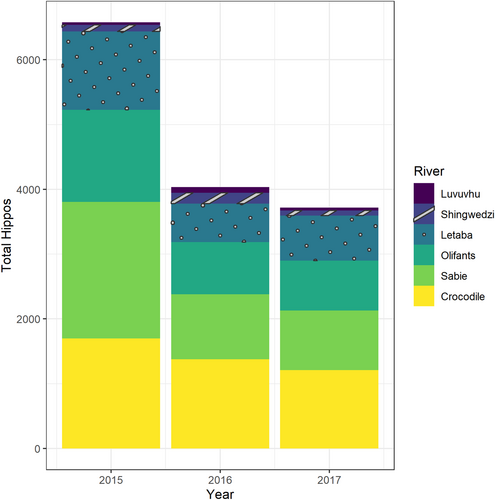
Aggregation of hippos appeared to decrease in response to the drought (i.e., between 2015 and 2016), but then increased between 2016 and 2017 when the rains returned. Specifically, we observed the number of river segments occupied by hippos decreased steadily from 2015 to 2016 and again to 2017. However, the decline in the number of occupied segments from 2015 to 2016 (~2%) was small relative to the drastic decline in the total number of hippos (~39%). In contrast, the per cent decline in occupied segments from 2016 to 2017 (15%) was almost twice the decline in total hippos during that year (8%, Table 1). Furthermore, group size decreased initially (i.e. from 2015 to 2016) but then increased between 2016 and 2017 (Table 1). As a result, the proportion of group size to the number of occupied sites decreased from 0.035 to 0.016 between 2015 and 2016 but then increased back up to 0.029 in 2017 (Table 1). This initial decrease in the proportion of group size to the number of occupied segments followed by a reaggregation from 2016 to 2017 was observed within all but one of the rivers (Figure 3).
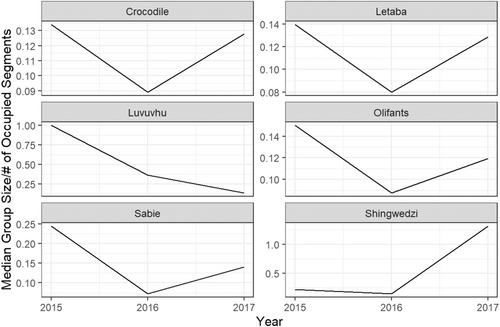
Prior to the drought, all environmental factors except slope were significantly (i.e. 95% CI did not include 0) related to hippo abundance in 2015 (Table 2). Hippo abundance was greatest in river segments at lower elevations., such that the predicted abundance of hippos within a 1-km river segment according to the baseline model was greater than 10 individuals at the lowest elevations (i.e. below 200 m), but this predicted abundance declined with increasing elevation, such that the predicted abundance was below five individuals at elevations greater than 300 m (Figure S1). The relationship between NDVI and hippo abundance was approximately linear, as reflected by the near-zero magnitude of the quadratic term (Table 2). The predicted hippo abundance was greater than 10 individuals where NDVI was <0.28, and less than five individuals where NDVI was >0.4 (Figure S1). Finally, the predicted hippo abundance increased from fewer than 10 hippos in segments with less than 10 ha of surface water to >15 hippos in segments with at least 20 ha of surface water (Figure S1).
| Model | Parameter | Estimate | SEa | p-Value |
|---|---|---|---|---|
| Baseline (2015 only) | Intercept | 1.83 | 0.51 | <0.01 |
| NDVIb | −0.45 | 0.11 | <0.01 | |
| NDVI2 | −0.01 | 0.06 | 0.82 | |
| Surface water | 0.17 | 0.04 | <0.01 | |
| Elevation | −0.45 | 0.07 | <0.01 | |
| Slope | −0.16 | 0.09 | 0.07 | |
| Drought (2015–2016) | Intercept | −4.24 | 0.91 | <0.01 |
| 2015 Hippos | −9.68 | 0.39 | <0.01 | |
| ΔNDVIc | 0.54 | 0.41 | 0.18 | |
| 2016 Surface water | 1.19 | 0.4 | <0.01 | |
| Elevation | 0.99 | 0.44 | 0.03 | |
| Slope | −0.3 | 0.44 | 0.49 | |
| Recovery (2016–2017) | Intercept | −0.52 | 0.36 | 0.15 |
| 2015 Hippos | 1.08 | 0.41 | 0.01 | |
| ΔNDVI | −0.32 | 0.4 | 0.43 | |
| 2017 Surface water | 0.03 | 0.41 | 0.93 | |
| Elevation | 0.36 | 0.41 | 0.38 | |
| Slope | 0.2 | 0.37 | 0.59 |
- Note: Shaded rows indicate p-value >0.05.
- a Standard error.
- b Normalized difference vegetation index.
- c Change in dry season NDVI from year 1 to year 2.
Examining changes in hippo abundance associated with the 2016 drought, we observed both elevation and the area of surface water during the drought were significantly related to the change in hippo abundance at the 0.05 level (Table 2). However, the magnitudes of these effects were small in comparison to that of the baseline hippo abundance and were potentially driven by a small number of river segments with extreme values (Figure 3). Although statistically significant, the magnitude of these effects was almost 10 times smaller than the effect of density dependence (Table 2). According to the drought model, the decrease in hippo abundance from 2015 to 2016 was approximately half of the initial hippo abundance, such that a segment that supported 50 hippos in 2015 decreased to only 22 hippos in 2016 (Figure 4a).
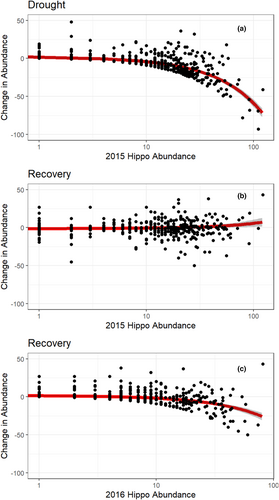
During the recovery period in the wake of the drought, we again found that our measure of density dependence appeared to play an important role in the response of hippos. The density dependence effect was significant (p < 0.05) regardless of whether we considered the ‘initial’ hippo abundance to be that from 2015 or 2016 (Table 2), however, the direction of this relationship changed depending on which year was considered to represent the initial abundance. Specifically, we found that river segments that supported more than 75 hippos before the drought (i.e. 2015) were predicted to gain hippos between 2016 and 2017 (Figure 4b). In contrast, river segments that supported at least 30 hippos in 2016 during the drought were predicted to decrease between 2016 and 2017 (Figure 4c). These effects of density dependence exceeded the threshold to account for the bias inherent to repeated measures. Specifically, the lower bound of the 95% confidence interval of the density dependence coefficient of the drought model (i.e. b2016) was 0.38, which exceeded the 0.18 threshold for significance. Similarly, the density dependence coefficient for the recovery model also exceeded this threshold, regardless of whether we considered 2015 or 2016 to represent the initial abundance.
DISCUSSION
Despite their relatively limited ability to migrate long distances, hippos did appear to move and alter their behaviours in response to a severe drought. However, this response appeared less successful in mitigating drought-induced mortality compared to other large savanna herbivores that were better able to migrate to areas less severely affected by drought (Smit et al., 2020). Accordingly, hippo populations may be acutely vulnerable to intraspecific competition and food scarcity during prolonged drought.
Stochasticity in resource availability often serves as an important regulatory mechanism of herbivore population dynamics, particularly when predation pressure is low (Sæther, 1997). For elephants and rhinos, for example, density-dependent responses may only become important above some population size threshold when resources are limited (Gough & Kerley, 2006; Okita-Ouma et al., 2009). To overcome this limitation, some megaherbivores move opportunistically to key resource areas during times of scarcity (Sinclair, 2003). Indeed, both elephants and buffalo appeared to cope with the 2016 drought by moving to areas less severely affected (Smit et al., 2020). In contrast, hippos’ dependence on daytime refugia appeared to limit their ability to mitigate the effects of the drought. In addition, the social structure of hippos may render them even more vulnerable to the effects of drought, as the tendency to aggregate exposes a population to elevated levels of competition (Taylor & Taylor, 1977), particularly when food resources become scarce.
The few instances where we observed increased hippo abundance likely reflected movement, as previous work revealed decreased conception rates during unfavourable environmental conditions such as drought (Smuts & Whyte, 1981). Thus, increases in hippo abundance in the Shingwedzi and Luvuvhu rivers, which supported few hippos prior to the drought, were likely due primarily to movement from other areas. Similarly, previous studies observed upstream movements, particularly among sub-adult males that were likely avoiding competitive exclusion in crowded downstream pools (Stears et al., 2019). These movements, in combination with high mortality in areas of high hippo density, likely contributed to the decreased aggregation we observed during the drought and may reflect a behavioural response of hippos to cope with drought conditions. The idea that this was an adaptive behaviour was further supported by the re-aggregation we observed as the rains returned. Thus, hippos do appear to adjust their movement and behaviour to cope with drought, however, these adjustments may simply not be sufficient during droughts that are particularly widespread, prolonged or severe.
Although we observed the hippo response to drought to be largely driven by density-dependent factors, we did find evidence that water resources were positively associated with local hippos’ densities, which suggests that resource limitation may play a more prominent role in regions where resources are more limiting or where the extent of protected areas is less expansive. For example, Stears et al. (2021) observed hippo aggregation in a few remaining pools in response to drought in Tanzania. In such contexts, dammed and impounded water may provide important refugia for hippos when pooled water becomes limited (Baker et al., 2020; Utete et al., 2017). However, increased aggregation during drought can have dramatic consequences for water quality and aquatic ecology within pools and downstream (Dutton et al., 2018; Subalusky et al., 2018). As projected economic development exacerbates continued water scarcity throughout sub-Saharan Africa (Leemhuis et al., 2017), there are likely to be consequences for not only hippo populations (Dutton et al., 2021) but also water quality and availability more broadly (McClain, 2013). Thus, careful consideration of the implications of future rural development in Africa will be critical not only to the conservation of hippos but also resilience to drought more broadly (Gebrehiwot & Gebrewahid, 2016).
Although hippos appear to change their behaviour to cope with drought, for example, by moving to new areas and changing the degree to which they are aggregated into groups, they appear more vulnerable to drought than other megaherbivores. As such, the combined effects of increasing human water demand and more variable precipitation cycles associated with climate change will likely have negative consequences for hippo populations. These results underscore the importance of water conservation for the persistence of African savannas' unique megafaunal populations.
AUTHOR CONTRIBUTIONS
Paul J. Taillie: Data curation (equal); formal analysis (equal); investigation (equal); methodology (equal); project administration (supporting); writing – original draft (equal). Jack Hartfelder: Conceptualization (supporting); data curation (equal); formal analysis (supporting); investigation (equal); methodology (equal); project administration (supporting); writing – review and editing (equal). Alex Potash: Data curation (supporting); formal analysis (supporting); writing – review and editing (supporting). Danie Pienaar: Data curation (supporting); investigation (supporting); project administration (supporting). Cathy Greaver: Conceptualization (supporting); data curation (supporting); investigation (supporting); project administration (supporting). Pauli Viljoen: Conceptualization (supporting); data curation (supporting); investigation (supporting); project administration (supporting). Robert Fletcher: Formal analysis (equal); methodology (equal); writing – review and editing (equal). Sam Ferreira: Conceptualization (equal); funding acquisition (equal); project administration (equal); writing – review and editing (equal). Robert McCleery: Conceptualization (equal); data curation (equal); formal analysis (supporting); funding acquisition (equal); investigation (equal); methodology (equal); project administration (equal); writing – review and editing (equal).
ACKNOWLEDGEMENTS
We thank South Africa National Parks (SANParks) Park Development Fund and SANParks Aerial Services for financial and logistical support. In addition, we thank the University of Florida Institute for Food and Agricultural Sciences (IFAS) for administrative support.
Open Research
DATA AVAILABILITY STATEMENT
We are happy to provide the data for the paper upon request.



